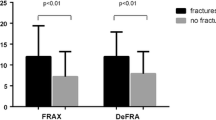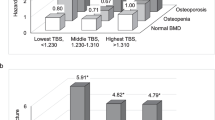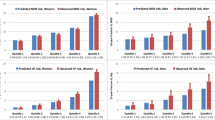Abstract
The ability to assess a patient’s risk of fracture is fundamental to the clinical role of bone densitometry. Fracture discrimination is quantified by the relative risk (RR), defined as the increased risk of fracture for a 1 standard deviation decrease in bone mineral density (BMD). The larger the value of RR, the more effective measurements are at identifying patients at risk of fracture. Epidemiological studies show that RR values for predicting the risk of any fracture are approximately the same for all BMD measurement sites. In this study, we show theoretically that this interesting observation is predictable and a consequence of two related observations: (1) that fracture prediction by BMD measurement sites distant from the fracture site is quantitatively explained by the correlation of BMD measurements and (2) that all correlation coefficients between distant BMD sites are comparable, with values in the range r = 0.55–0.65. The first of these conditions (referred to as the correlation hypothesis) is important because it sets a lower limit on the RR values at distant BMD sites on the assumption that measurements at these sites contain no independent information about fracture risk over and above that provided by their correlation with the fracture site BMD. If the correlation hypothesis is true, the present study points to the importance of the correlation coefficient between BMD sites as a key index that is indicative of the ability of different types of measurement to predict fracture risk. If, on the contrary, the correlation hypothesis is not valid, there is scope to improve bone densitometry by further studies to better identify those measurements that do provide independent information about fracture risk and how best to integrate this information with existing techniques to improve decision making.





Similar content being viewed by others
References
Cooper C, Campion G, Melton LJ (1992) Hip fractures in the elderly: a world-wide projection. Osteoporosis Int 2:285–289
Ray NF, Chan JK, Thamer M, Melton LJ (1997) Medical expenditures for the treatment of osteoporotic fractures in the United States in 1995: report from the National Osteoporosis Foundation. J Bone Miner Res 12:24–35
Black DM, Cummings SR, Karpf DB, Cauley JA, Thompson DE, Nevitt MC, Bauer DC, Genant HK, Haskell WL, Marcus R, Ott SM, Torner JC, Quandt SA, Reiss TF, Ensrud KE (1996) Randomised trial of the effect of alendronate on risk of fracture in women with existing vertebral fractures. Lancet 348:1535–1541
McClung MR, Geusens P, Miller PD, Zippel H, Bensen WG, Roux C, Adami S, Fogelman I, Diamond T, Eastell R, Meunier PJ, Reginster J-Y (2001) Effect of risedronate treatment on hip fracture risk in elderly women. N Engl J Med 344:333–340
Neer RM, Arnaud CD, Zanchetta JR, Prince R, Gaich GA, Reginster J-Y, Hodsman AB, Eriksen EF, Ish-Shalom S, Genant HK, Wang O, Mitlak BH (2001) Effect of recombinant human parathyroid hormone (1-34) fragment on spine and non-spine fractures and bone mineral density in postmenopausal osteoporosis. N Engl J Med 344:1434–1441
Kanis JA, Delmas P, Burckhardt P, Cooper C, Torgerson D, on behalf of the European Foundation for Osteoporosis, Bone Disease (1997) Guidelines for diagnosis and treatment of osteoporosis. Osteoporosis Int 7:390–406
Royal College of Physicians (1999) Osteoporosis: clinical guidelines for prevention and treatment. RCP, London
National Osteoporosis Society (2002) Position statement on the reporting of dual X-ray absorptiometry (DXA) bone mineral density scans. Bath, UK
Marshall D, Johnell O, Wedel H (1996) Meta-analysis of how well measures of bone mineral density predict occurrence of osteoporotic fractures. Br Med J 312:1254–1259
Stone KL, Seeley DG, Lui L-Y, Cauley JA, Ensrud K, Browner WS, Nevitt MC, Cummings SR (2003) BMD at multiple sites and risk of fracture of multiple types: long-term results from the Study of Osteoporotic Fractures. J Bone Miner Res 18:1947–1954
Eastell R (1998) Treatment of postmenopausal osteoporosis. N Engl J Med 338:736–746
World Health Organization (1994) Assessment of fracture risk and its application to screening for postmenopausal osteoporosis. WHO Technical Report Series 843. WHO, Geneva
Genant HK, Engelke K, Fuerst T, Gluer C-C, Grampp S, Harris ST, Jergas M, Lang T, Lu Y, Majumdar S, Mathur A, Takada M (1996) Noninvasive assessment of bone mineral and structure: state of the art. J Bone Miner Res 11:707–730
Glüer C-C, Jergas M, Hans D (1997) Peripheral measurement techniques for the assessment of osteoporosis. Semin Nucl Med 27:229–247
Jones T, Davie M (1998) Bone mineral density at distal forearm can identify patients with osteoporosis at spine or femoral neck. Br J Rheumatol 37:539–543
Fordham JN, Chinn DJ, Kumar N (2000) Identification of women with reduced bone density at the lumbar spine and femoral neck using BMD at the os calcis. Osteoporosis Int 11:797–802
Blake GM, Fogelman I (2001) Peripheral or central densitometry: does it matter which technique we use? J Clin Densitom 4:83–96
Miller PD, Siris ES, Barrett-Connor E, Faulkner KG, Wehren LE, Abbott TA, Chen Y-T, Berger ML, Santora AC, Sherwood LM (2002) Prediction of fracture risk in postmenopausal white women with peripheral bone densitometry: evidence from the National Osteoporosis Risk Assessment. J Bone Miner Res 17:2222–2230
Blake GM, Fogelman I (2005) Fracture prediction by bone density measurements at sites other than the fracture site: the contribution of BMD correlation. Calcif Tissue Int 76:249–255
Lu Y, Genant HK, Shepherd J, Zhao S, Mathur A, Fuerst TP, Cummings SR (2001) Classification of osteoporosis based on bone mineral densities. J Bone Miner Res 16:901–910
Patel R, Blake GM, Fogelman I (2004) An evaluation of the National Osteoporosis Society position statement on the use of peripheral X-ray absorptiometry. Osteoporosis Int 15:497–504
Svendsen OL, Hassager C, Skodt V, Christiansen C (1995) Impact of soft tissue on in-vivo accuracy of bone mineral measurements in the spine, hip and forearm: a human cadaver study. J Bone Miner Res 10:868–873
Seeley DG, Browner WS, Nevitt MC, Genant HK, Scott JC, Cummings SR (1991) Which fractures are associated with low appendicular bone mass in elderly women? Ann Intern Med 115:837–842
Grampp S, Genant HK, Mathur A, Lang P, Jergas M, Takada M, Gluer C-C, Lu Y, Chavez M (1997) Comparisons of non-invasive bone mineral measurements in assessing age-related bone loss, fracture discrimination and diagnostic classification. J Bone Miner Res 12:697–711
Knapp KM, Andrew T, MacGregor AJ, Blake GM, Fogelman I, Spector TD (2003) An investigation of the unique and shared gene effects on speed of sound and bone density using axial transmission quantitative ultrasound and dual X-ray absorptiometry in twins. J Bone Miner Res 18:1525–1530
Knapp KM, Blake GM, Spector TD, Fogelman I (2001) Multisite quantitative ultrasound: precision, age and menopause related changes, fracture discrimination and T-score equivalence with dual X-ray absorptiometry. Osteoporosis Int 12:456–464
Clowes JA, Peel NFA, Eastell R (2002) Fractures of the distal forearm, humerus, hip and vertebrae: association with peripheral and axial densitometry measurements. J Bone Miner Res 17:S186
Kullenberg R, Falch JA (2003) Prevalence of osteoporosis using bone mineral measurements at the calcaneus by dual X-ray and laser (DXL). Osteoporosis Int 14:823–827
Bauer DC, Gluer C-C, Cauley JA, Vogt TM, Ensrud KE, Genant HK, Black DM (1997) Broadband ultrasonic attenuation predicts fractures strongly and independently of densitometry in older women. Arch Intern Med 157:629–634
Hans D, Dargent-Molina P, Schott AM, Sebert JL, Cormier C, Kotzki PO, Delmas PD, Pouilles JM, Breart G, Meunier PJ (1996) Ultrasonographic heel measurements to predict hip fracture in elderly women: the EPIDOS prospective study. Lancet 348:511–514
Blake GM, Fogelman I (2004) Bone densitometry and fracture risk prediction. Eur J Nucl Med 31:785–786
Author information
Authors and Affiliations
Corresponding author
Rights and permissions
About this article
Cite this article
Blake, G.M., Knapp, K.M., Spector, T.D. et al. Predicting the Risk of Fracture at Any Site in the Skeleton: Are All Bone Mineral Density Measurement Sites Equally Effective?. Calcif Tissue Int 78, 9–17 (2006). https://doi.org/10.1007/s00223-005-0127-3
Received:
Accepted:
Published:
Issue Date:
DOI: https://doi.org/10.1007/s00223-005-0127-3




